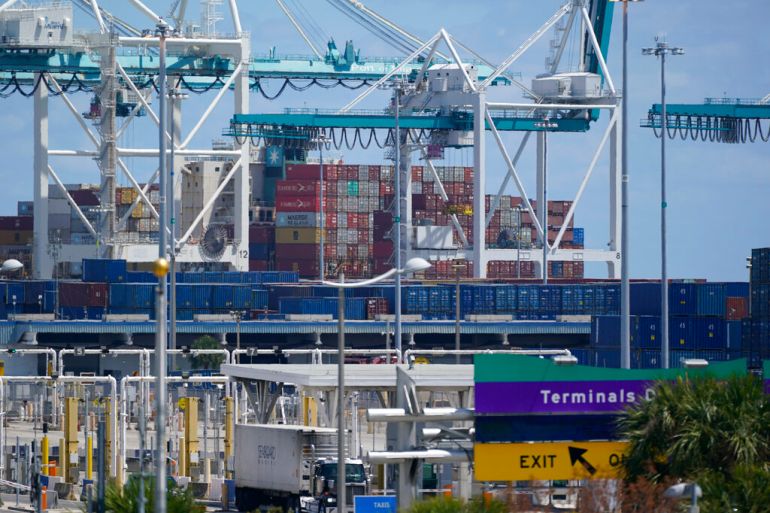US trade deficit narrows in October as exports jump
The October deficit was 17.6 percent below the all-time peak in September of $81.4bn, the Commerce Department said on Tuesday.

The United States trade deficit narrowed to $67.1bn in October, the lowest in six months, after hitting a record high in September. A big rebound in exports helped to offset a much smaller rise in imports.
The October deficit was 17.6 percent below the all-time peak in September of $81.4bn, the Commerce Department reported on Tuesday. It was the smallest monthly deficit since a $66.2bn imbalance in April.
Keep reading
list of 4 itemsUAE announces 4.5-day workweek, Saturday-Sunday weekend
China claims to have ‘democracy that works’ ahead of Biden summit
Biden mulls blacklisting Russian banks if Putin invades Ukraine
The strong rebound in exports is seen by economists as evidence of global supply chains beginning to untangle, and they believe smaller deficits this quarter could give a solid boost to overall US economic growth.
There were gains in numerous export categories, suggesting that a recovering global economy is beginning to boost demand for US products. Americans’ demand for imports had been racing ahead of export sales as the US economy recovered more quickly than other countries from the pandemic.
In October, exports rose 8.1 percent to $223.6bn while imports were up a much smaller 0.9 percent to $290.7bn. The deficit is the gap between what the US exports to the rest of the world and the imports it buys from foreign nations.
The politically sensitive trade deficit with China, the largest with any country, fell by 14 percent in October to $31.4bn. For the first 10 months of this year, the deficit in goods trade with China is running 13.7 percent higher than a year ago.
The US’s overall deficit trade deficit totalled $705.2bn so far this year, 29.7 percent above the same period a year ago. Trade flows were sharply curtailed last year as the COVID pandemic restricted economic activity.
Part of the October increase in exports reflected a surge in oil exports, showing a return to more normal operations at Gulf Coast refineries that had been shut down by Hurricane Ida.
Big gains in US auto exports and imports suggest that the global computer chip shortage which had crimped auto production was beginning to ease, a trend that has been noted by leaders in the auto industry.
Andrew Hunter, senior US economist at Capital Economics, predicted that an improving trade picture would add approximately 1 percentage point to US economic growth in the current October-December quarter. He expects the gross domestic product to expand at an annual rate of 6.5 percent this quarter, a significant improvement from the modest 2.1 percent growth rate in the third quarter.
While the trade report offered evidence that supply chain problems were easing, Hunter noted that while the number of waiting ships anchored off US ports has declined in recent weeks, they remain at “historically high levels”.
He also cautioned that the emergence of the new Omicron variant of the coronavirus and the travel restrictions that have been reinstated could dampen services trade in the coming months.
Tuesday’s report showed that the deficit in goods totalled $83.9bn in October while US’s surplus in services trade, which includes airline and other travel payments, totalled $16.8bn.